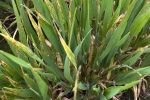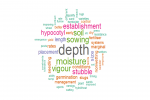Canola’s place in the north is being explored via a GRDC National Grower Network project demonstrating its economic and agronomic potential
Figure 1: NGN projects across the northern region.

Source: Kynetec
Although chickpeas are the dominant winter cash crop for growers in southern Queensland, interest in canola as an alternative is steadily growing.
Queensland Department of Primary Industries (DPI) research agronomist Jordan Davis says canola produced in the north has a farming systems advantage: “Growers can capitalise on early planting and harvest windows to spread logistics and marketing risk. This enhances profitability.”
Despite the risk of growing canola in a heat-stressed environment, growers are still keen to explore the option.
Via a GRDC National Grower Network project, Mr Davis is trialling varieties and agronomic practices to evaluate adaptability and canola’s northern potential.
In 2024, trials included six varieties of varying maturity length.
They were benchmarked against wheat and faba beans to compare competitive rotational alternatives.
“While chickpeas are planted in June, canola, faba bean and wheat can all be planted in early April.
“As well as a different planting window, faba bean and canola offer rotational benefits and potential market access options,” Mr Davis says.
Disc and tyne treatments were analysed to assess the effect on germination, establishment and yield.
“Canola is not that common in Queensland. So, we included both disc and tyne treatments to observe how we can get this small seed out of the ground in our part of the world.
“This is only our first year of the trials so we can anticipate pest and agronomy management challenges, but the potential of canola in Queensland is looking promising.”
Results
The canola varieties all had similar yields of about two tonnes per hectare.
“This is a good yield and ranged from one tonne to 2.5t/ha, rivalling the 2.5t/ha yields usually seen in irrigated environments or southern climates with winter-dominant rain.”
The benchmark crops of wheat and faba beans yielded 3.5t/ha and 2.2t/ha, respectively.
 Research agronomist Jordan Davis. Photo: courtesy Jordan Davis
Research agronomist Jordan Davis. Photo: courtesy Jordan Davis
Mr Davies says canola in southern Queensland has less yield loss from frost as typically only the flowers on that day are lost.
“And growing early maturing varieties reduces the early season heat risk.”
While there are beneficial effects on nutrient cycling and a reduction in disease pressure, especially crown rot, canola may have some negatives as well.
“Canola tends to compensate for cooler weather but struggles to recover when temperatures rise. If canola is planted too late or a variety is too slow, then heat stress during flowering and grain fill could become an issue.”
This may lead to yield penalties when canola aborts flowers, impacting grain fill. This also increases protein levels and reduces oil content. “This reduces market options.”
Additional risks include pod shattering, so harvest timing is critical.
“The harvest window for canola is pretty small. If you windrow or harvest too late, then you are at risk of the plant being too dry and the seed pods shattering. If too early, then you lose yield as the late pods are still filling.”
Mr Davis says to determine accurate harvest timing, monitoring is required.
“Look at the moisture content of the crop and how the seed pods are holding up. As they lose moisture, the pods shatter and lose seed. Then you need to harvest at the ideal time. A two-day difference may have an impact on how much grain you harvest.”
2025 trials
This year, Mr Davis and the DPI team plan to have more than 180 plots. This will enable them to observe and analyse a wider range of varieties, taking a ‘deep dive’ into varietal influence.
“We will also incorporate variations in nitrogen rates, application methods and timing to gauge yield effects. We want growers to be able to make informed decisions based on variations in starting nitrogen and to see the effect on yield.”
In 2024, field walks were hosted at both trial sites – Goondiwindi and Warra – and more are planned in 2025.
“We aim to assess the potential of canola grown under average commercial field conditions in southern Queensland. We will also monitor growers’ commercial crops. This will help us create case studies to see how they perform, gaining insight into practices already being undertaken.”
More information: Jordan Davis, jordan.davis@daf.qld.gov.au
Resources: Canola northern region – GrowNotesTM

Canola is not that common in Queensland. Research via an NGN project aims to work out best practice canola cropping. Photo: courtesty Jordan Davis
Agronomic opportunities
As well as potential financial incentives, growing canola also offers a weed, disease and pest break, says Jordan Davis, Queensland Department of Primary Industries research agronomist.
“Growers focus on improving soil health,” he says.
“Using faba beans as a trusted alternative is best management practice. However, including canola in the rotation may provide a further reduction in weed, disease and pest pressure and increased nutrient cycling due to its large biomass. If the opportunity arises, growers will plant chickpeas.
If they want a rotation that breaks the disease and pest cycle while cycling nutrients back into the system, then faba bean is the way to go. Canola is just another alternative to spread risk.
What is the NGN?
GRDC’s National Grower Network (NGN) is an open community of growers and grains industry stakeholders that was established in 2021. Engaging directly with stakeholders through forums, the NGN helps GRDC develop locally relevant research, development and extension (RD&E) investments.
This might be through short-term, local investments to address a specific issue, by informing large investments in GRDC’s broader portfolio, or ensuring relevant national projects include local RD&E when the need is identified.
Its key features are to:
- support meaningful engagement with growers, advisers and other industry stakeholders
- improve understanding of local issues
- assist in the development of locally relevant investments that are timely and have on-farm impact.
GRDC senior regional manager – north Rebecca Raymond says engagement with growers through the NGN process improves how GRDC delivers RD&E across its investment portfolio.
The NGN process also provides more flexibility to respond to local issues.
For example, in July 2024 at an NGN forum in Bellata, NSW, growers raised concerns around correct disease identification so they can implement effective management strategies.
GRDC consulted industry experts then went to market to engage a service provider to deliver disease identification workshops and supporting material. A contract was signed earlier this year with workshops planned in the second half of 2025.
More information: GRDC National Grower Network.

























































